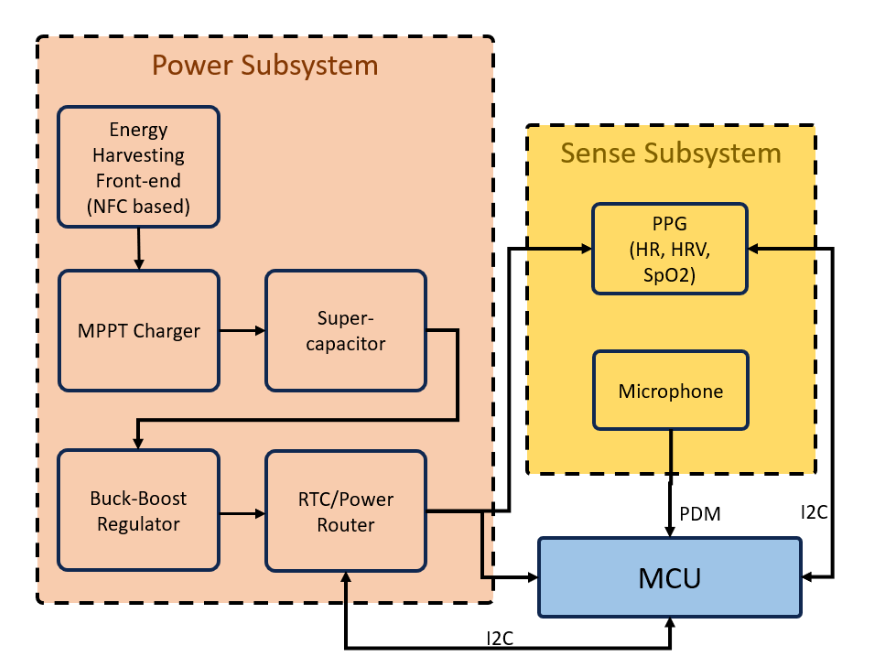BioPulse: Towards Enabling Perpetual Vital Signs Monitoring using a Body Patch
Authors: C.Rajashekar Reddy, Vivian Dsouza, Ashok Samraj Thangarajan, Przemyslaw Pawelczak, Fahim Kawsar, Alessandro Montanari
In The 26th International Workshop on Mobile Computing Systems and Applications (HOTMOBILE '25), 2025
[Paper pdf] [Poster]

Abstract: Continuous monitoring of vital signs has become increasingly im- portant for digital healthcare and enhancing self-awareness. Wearable devices like smartwatches, earbuds, and rings are gaining widespread acceptance for health monitoring. However, two significant challenges remain: (i) the limited battery life of these devices makes them unsustainable for long-term use, and (ii) many older adults, who would benefit most from health monitoring, often face barriers due to limited digital literacy. To address these issues, we introduce BioPulse—a perpetual, patch form-factor device designed for continuous monitoring. BioPulse estimates key parameters for cardiac health such as heart rate, heart rate variability, and blood pressure. By utilising a sparse sampling algorithm alongside NFC- based energy transfer and communication, the system operates without a battery, achieving a 57.9% reduction in power consumption. The system demonstrates a mean absolute error of 5.6 mmHg for systolic blood pressure (SBP) and 4.5 mmHg for diastolic blood pressure (DBP) compared to the ground truth device. This combination ensures a more sustainable and accessible solution for vital signs monitoring

ACM Reference Format
C. Rajashekar Reddy, Vivian Dsouza, Ashok Samraj Thangarajan, Przemysław Pawełczak, Fahim Kawsar, and Alessandro Montanari. 2025. BioPulse: Towards Enabling Perpetual Vital Signs Monitoring using a Body Patch. In Proceedings of the 26th International Workshop on Mobile Computing Systems and Applications (HotMobile '25). Association for Computing Machinery, New York, NY, USA, 103–108. //doi.org/10.1145/3708468.3711891
@inproceedings{10.1145/3708468.3711891,
author = {Reddy, C. Rajashekar and Dsouza, Vivian and Thangarajan, Ashok Samraj and Pawe\l{}czak, Przemys\l{}aw and Kawsar, Fahim and Montanari, Alessandro},
title = {BioPulse: Towards Enabling Perpetual Vital Signs Monitoring using a Body Patch},
year = {2025},
isbn = {9798400714030},
publisher = {Association for Computing Machinery},
address = {New York, NY, USA},
url = {https://doi.org/10.1145/3708468.3711891},
doi = {10.1145/3708468.3711891},
abstract = {Continuous monitoring of vital signs has become increasingly important for digital healthcare and enhancing self-awareness. Wearable devices like smartwatches, earbuds, and rings are gaining widespread acceptance for health monitoring. However, two significant challenges remain: (i) the limited battery life of these devices makes them unsustainable for long-term use, and (ii) many older adults, who would benefit most from health monitoring, often face barriers due to limited digital literacy. To address these issues, we introduce BioPulse---a perpetual, patch form-factor device designed for continuous monitoring. BioPulse estimates key parameters for cardiac health such as heart rate, heart rate variability, and blood pressure. By utilising a sparse sampling algorithm alongside NFC-based energy transfer and communication, the system operates without a battery, achieving a 57.9\% reduction in power consumption. The system demonstrates a mean absolute error of 5.6 mmHg for systolic blood pressure (SBP) and 4.5 mmHg for diastolic blood pressure (DBP) compared to the ground truth device. This combination ensures a more sustainable and accessible solution for vital signs monitoring.},
booktitle = {Proceedings of the 26th International Workshop on Mobile Computing Systems and Applications},
pages = {103–108},
numpages = {6},
keywords = {Batteryless, Blood pressure sensing, Sparse Sampling},
location = {La Quinta, CA, USA},
series = {HotMobile '25}
}